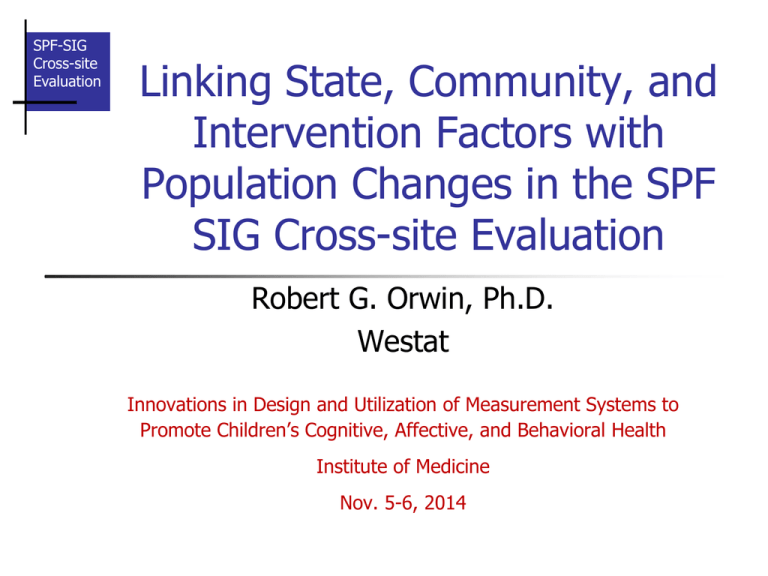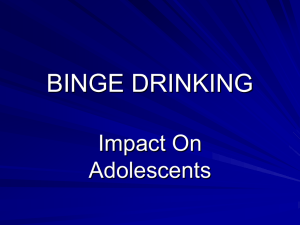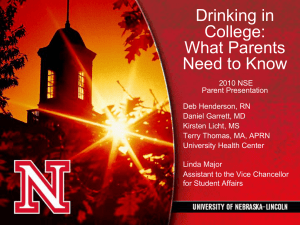Post - Institute of Medicine
advertisement

SPF-SIG Cross-site Evaluation Linking State, Community, and Intervention Factors with Population Changes in the SPF SIG Cross-site Evaluation Robert G. Orwin, Ph.D. Westat Innovations in Design and Utilization of Measurement Systems to Promote Children’s Cognitive, Affective, and Behavioral Health Institute of Medicine Nov. 5-6, 2014 Strategic Prevention Framework (SPF) goals 1. Prevent the onset and reduce the progression of substance abuse, including childhood and underage drinking; 2. Reduce substance abuse-related problems in communities; and 3. Build prevention capacity and infrastructure at the state/territory and community levels SPF-SIG Cross-site Evaluation CSAP funded the States to implement the SPF model. NIDA funded a national evaluation of SPF SIG through an interagency agreement. The SPF model SPF-SIG Cross-site Evaluation How does SPF differ from prior Federal prevention efforts? There are many novel aspects of SPF, with two particularly relevant for the IOM conference theme: SPF-SIG Cross-site Evaluation the required use of epidemiological data to set state priorities and justify resource allocation to communities (so-called “data-driven planning”) reliance on population-based outcomes to estimate the initiative’s effectiveness, in contrast to the more traditional reliance on program-level effects on individual participants Who participated? 26 states and 2 territories 450 communities 2,534 interventions SPF-SIG Cross-site Evaluation Research questions relying on population data Both within and across states, did SPFfunded intervention activities lead to community-level improvements in the priorities targeted by those communities? What accounted for variation in outcome performance across funded communities? SPF-SIG Cross-site Evaluation Criteria used for including states and outcomes For Community-Level Analyses: At least 3 communities1 have at least 1 preintervention and one year post-intervention2 data point For State-Level Analyses (high coverage states only): State-level data available for at least one preintervention and one post-intervention2 data point SPF-SIG Cross-site Evaluation 1Unless communities are matched 2Post intervention is the first year following initial exposure to activities Summary of community-level outcomes analyses: Pre-post (by communities) Outcome Measure SPF-SIG Cross-site Evaluation # States Pre-Post Better Sig. Better Sig. Worse 30-day alcohol use – MS/HS 174 132 79 15 Binge drinking – MS/HS 154 100 56 18 Binge drinking – young adult 47 25 14 6 Drive after drinking – MS/HS 78 56 28 4 30-day marijuana – MS/HS 7 4 3 0 ARMVC measure – all ages 113 70 -- -- All other outcome measures1 141 83 36 8 1Communities counted according to the number of measures they contribute Summary of community-level outcomes analyses: Pre-post (by states) Outcome Measure SPF-SIG Cross-site Evaluation # States Pre-Post Better Sig. Better Sig. Worse 30-day alcohol use – MS/HS 16 14 11 1 Binge drinking – MS/HS 12 10 8 2 Binge drinking – young adult 3 2 1 1 Drive after drinking – MS/HS 6 5 3 0 30-day marijuana – MS/HS 2 2 2 0 ARMVC measure – all ages 8 8 -- -- All other outcome measures1 21 16 10 1 1States counted according to the number of measures they contribute Summary of community-level outcomes analysis results: Comparative (by states) Outcome Measure # states with comp comm data # states means improved relative to comps Sig. Better Sig. Worse 30-day alcohol use – MS/HS 7 2 2 0 Binge drinking – MS/HS 4 3 1 0 Binge drinking – young adult 1 1 0 0 Drive after drinking – MS/HS 3 3 1 0 30-day marijuana – MS/HS 2 2 2 0 4 4 -- -- 15 11 2 0 SPF-SIG Cross-siteARMVC Evaluation measure – all ages All other outcome measures1 1States counted according to the number of measures they contribute Summary of State-level outcomes analyses: Pre-post * Outcome Measure SPF-SIG Cross-site Evaluation N of States N with greater rel. decrease than U.S. 30-day alcohol use – HS students 7 5 Binge drinking – HS students 7 5 Binge drinking – young adults or adults 7 7 Driving after drinking – HS students 4 4 % MVC Fatalities that are alcohol-related 4 2 *For 7 high coverage states (Guam and Palau not included) General assessment of patterns observed in outcomes SPF-SIG Cross-site Evaluation Favorable community-level pre-post changes were observed across most targeting communities for most measures In many cases, similar pre-post changes were also observed in comparison communities (or statewide) Even so, about 2/3 of targeting communities and states improved relative to their comparison communities The 7 high coverage states improved relative to the U.S. on about 4/5 of the statewide outcome measures assessed So what explains success? To the extent the SPF model was effective in reducing substance abuse and its consequences, what contributed? 3 levels of predictors: SPF-SIG Cross-site Evaluation State Community Intervention (aggregated w/i community) State-level predictors * State-level implementation State-level infrastructure State population SPF-SIG Cross-site Evaluation * State-level predictors entered at level 3 in the multilevel models, which also included intercept and slope terms to adjust for effects of secular trend and pre-implementation differences across communities, plus level 2 and 3 variance terms. Community-level predictors * Funding and Organizational Support Coalition Capacity SPF Step Scores Intervention Variables SPF-SIG Cross-site Evaluation * Community-level predictors entered at level 2 in the multilevel models, which also included intercept and slope terms to adjust for effects of secular trend and pre-implementation differences across communities, plus level 2 and 3 variance terms. State-level predictors Of the implementation scores, only Step 3 (strategic planning) predicted significant change in a targeted outcome in the multilevel models. The other step implementation scores tested (1, 2 and 5) and the summary score had no observable effect. SPF-SIG Cross-site Evaluation Of the five state infrastructure domain and two integration scores, only the EBPPP domain score predicted outcome change in the fully weighted model, and not in the anticipated direction. Consistent with expectations, states with larger populations had weaker community effects. Community-level predictors Funding and Organizational Support In general, communities that received additional prevention $ beyond their SPF funding were more likely to achieve significant reductions on their targeted outcomes. However, the results depended on the funding source. SPF-SIG Cross-site Evaluation Specifically, federal SAPT funds and county or municipal funds predicted significant favorable outcome change. Other sources had little or no observable effect. With few exceptions, organizational support variables tested had no observable effect on outcome change. Community-level predictors Coalition Capacity Among CP’s who self-identified as coalitions, higher scores on coalition attributes predicted significantly greater reductions in one or more underage drinking outcomes. SPF-SIG Cross-site Evaluation Specifically, coalitions with good structure and processes in place, paid leadership, funding from other sources, membership diversity, and supportive communities achieved better outcomes. A summary coalition capacity score constructed from those items was also significant. Community-level predictors Intervention Variables Strategy selection SPF-SIG Cross-site Evaluation N or % of strategies in several strategy classes – including environmental -- predicted significantly greater reduction in one or more underage drinking outcomes. N or % of strategies in several domains – including society/environmental – also predicted favorable change. N of interventions implemented had no observable effect, nor did N or % of interventions identified as evidence-based. Community-level predictors Intervention Variables (cont.) Strategy adaptation SPF-SIG Cross-site Evaluation Reported modifications to dosage, duration, and setting – all traditional targets of adaptation in participantbased interventions -- had no observable effect. Adaptations to better meet the needs of the target population or improve cultural appropriateness predicted a favorable change in one or more underage drinking outcomes, as did the overall N or % of interventions with any type of adaptation. Implications for the conference theme Do this more Do it better Explain it simply Protect and expand the data systems that make it possible SPF-SIG Cross-site Evaluation Questions? Rob Orwin robertorwin@westat.com SPF-SIG Cross-site Evaluation






